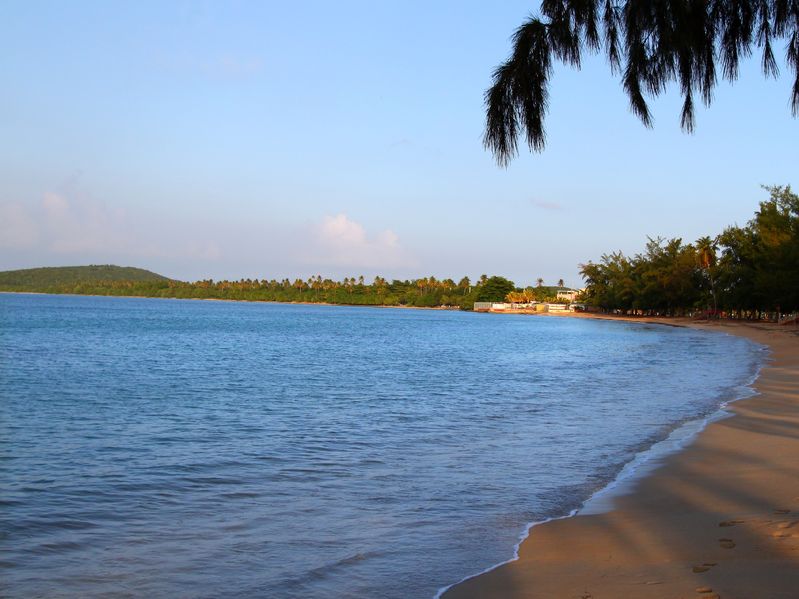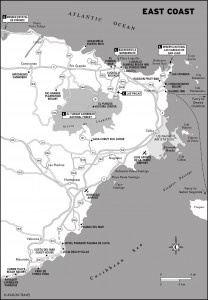
Balneario Seven Seas is a great beach for swimming and snorkeling. Photo © Jason Ross/123rf.

East Coast
Fajardo is a bustling little seaside town notable for its marinas and water sports enthusiasts. It’s also an excellent seaborne transportation hub to Caribbean points east, where you can catch a ferry or sailboat to Vieques, Culebra, St. Thomas, and beyond.Although it has a town proper with the requisite plaza and church, the heart of Fajardo is along the coast, where hundreds of vessels dock and dozens of seafood restaurants vie to serve the day-trippers who flock here for the superb diving, fishing, sailing, and golf.
Fajardo is also home to one of the island’s bioluminescent lagoons, Laguna Grande, in Reserva Natural Las Cabezas de San Juan. Here you can kayak at night and marvel at the phosphorescent microorganisms that light up the water with a sparkling green glow.
Balneario Seven Seas (Carr. 987, beside Las Cabezas de San Juan, Las Croabas, 787/863- 8180, Wed.-Sun. 8:30 a.m.-5 p.m., open daily during summer, $5 per vehicle) is a great beach for swimming and snorkeling. For underwater action, check out the reef on the far eastern end of the beach. Camping for RVs and tents is also available, although quarters are close so don’t expect much privacy. Call 787/863-8180 for reservations.
Parque Las Croabas (Carr. 987) is a pleasant waterside park overlooking Bahía Las Croabas, dotted with moored fishing boats. From here you can see the island of Vieques. There are several concrete picnic shelters, poorly maintained bathroom facilities, and a small boat launch. Across the street are several bars and restaurants serving seafood. At dusk the park hums with activity because this is the launch site for all the kayak outfitters offering guided bio-bay tours in Laguna Grande.
Reserva Natural La Cordillera, comprising Icacos, Diablo, Palomino, and Palominitos, is a protected string of small sandy islands just north and east of Fajardo with lots of great snorkeling and diving spots around them. Bring plenty of water and sunscreen—there are no facilities or stores on the islands. To get there, go to the dock in Las Croabas and arrange a ride with one of the boat operators there. They’ll drop you off and return later to pick you up. The cost is typically $10 each way. The islands can get crowded on weekends and holidays.
Reserva Natural Las Cabezas de San Juan/El Faro (Carr. 987, km 6, 787/860-2560 or 787/722-5882, guided tours Wed.-Sun. 9:30 a.m., 10 a.m., 10:30 a.m., 2 p.m., $7 adults, $5 seniors and children 11 and younger, free for children 4 and younger, reservations required) is a unique and treasured piece of island property that has been protected from encroaching development. This 316-acre piece of land contains examples of all the island’s natural habitats except for the rainforest: coral reefs, turtle grass, sandy and rocky beaches, lagoons, a dry forest, and a mangrove forest. It is home to many endangered wildlife species, including the osprey and the sea turtle, and artifacts of the Igneri Indians, precursors to the Taínos, have been excavated here.
Two main points of interest are found at Las Cabezas de San Juan. One is the neoclassical lighthouse (el faro), built by the Spanish in 1880, making it the island’s second-oldest lighthouse. Today it houses facilities for scientific research in the areas of ecology, marine biology, geology, and archaeology.
The other highlight of Las Cabezas de San Juan is Laguna Grande, a mangrove lagoon filled with microscopic bioluminescent organisms that glow green at night when they sense motion. Several outfitters in the area offer canoe or kayak rides into the lagoon after dark on moonless nights so visitors can witness the biological phenomenon. Swimming in the lagoon is no longer permitted.
This rich nature reserve also features a nature center, hiking trails, a boardwalk, and an observation tower from which you can see El Yunque and nearby islands as far away as Tortola. Entrance into Las Cabezas de San Juan is by guided tour only. Call for reservations. To get here, take Carretera 3 to the Conquistador Avenue exit and turn left on Carretera 987. The reserve is on the left after Balneario Seven Seas recreation area.
Excerpted from the Fifth Edition of Moon Puerto Rico.